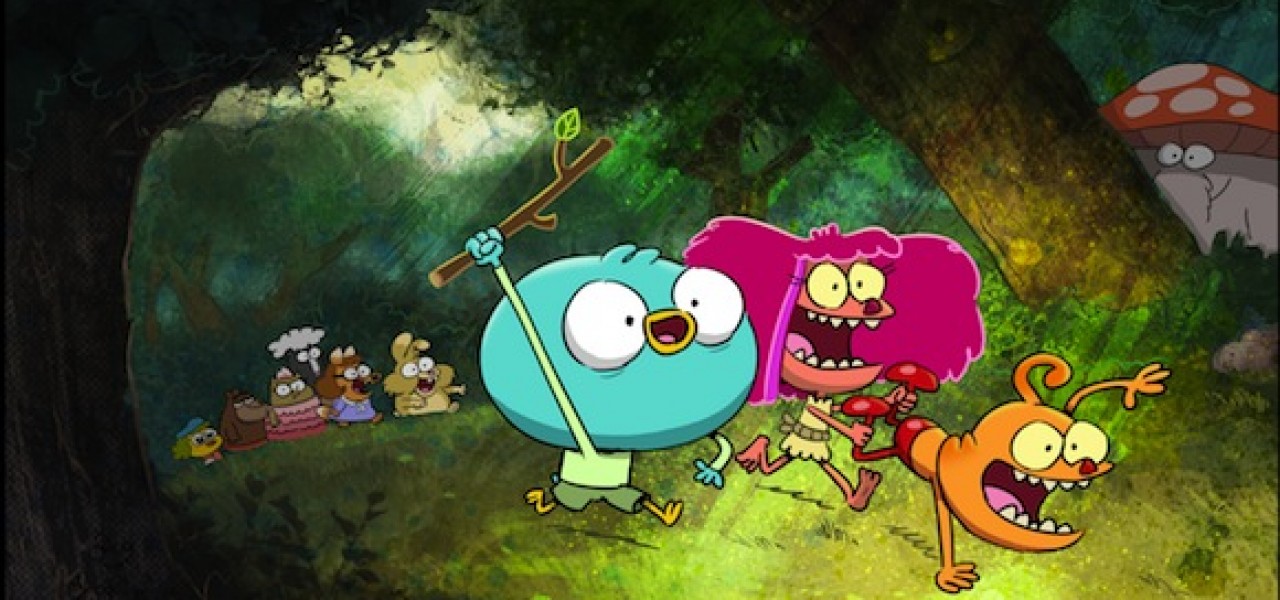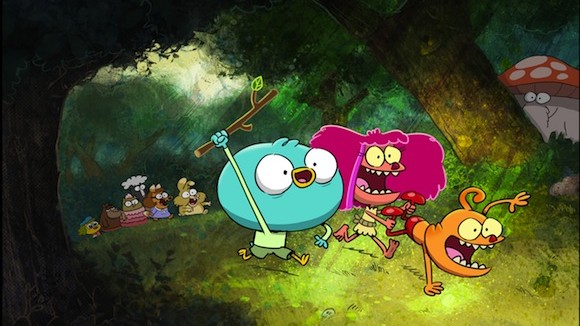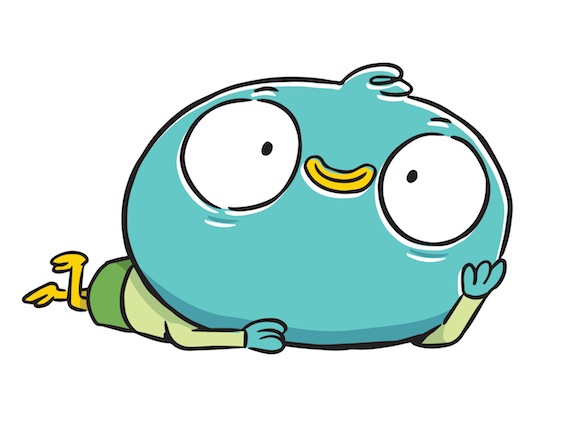

‘Harvey Beaks’ Creator C.H. Greenblatt on How to Break Into The Biz and Why Artists Should Post on Tumblr
After abandoning a career in advertising to respond to a magazine ad from Nickelodeon, Carl Harvey Greenblatt has logged a decade-and-a-half across studios and shows, including Nickelodeon’s SpongeBob Squarepants, Cartoon Network’s Chowder and The Grim Adventures of Billy & Mandy, Disney’s Fish Hooks and—back at Nickelodeon again—the new series Harvey Beaks.
Premiering this Sunday night after a special Saturday night sneak peek, Harvey Beaks is a mellower, more mature effort than Greenblatt’s rambunctious kitchen comedy Chowder. Its eponymous bird—named after its creator—is sincere, thoughtful, mild-mannered, and frequently at odds with his trouble-making friends Fee and Foo.
Cartoon Brew spoke with Greenblatt about his career and his new series, as well as the pleasures of Nickelodeon over Cartoon Network, whether it matters what art school a student attends, and the key role that Tumblr served in making the show.

CARTOON BREW: What drew you to animation, and why?
C.H. GREENBLATT: It’s the kind of thing where you look back and say, “I was always meant to do this.” Growing up in the ’80s, I would watch every single cartoon I could, even the terrible ones. I was the kid who knew the different studios and directors; I really paid attention to that kind of stuff. Then around the sixth grade, I started my own daily comic strips. That’s what I thought I would do for a living. I wrote comics every day, and showed them off to my friends through high school and college. I didn’t necessarily think animation was something I could do. I loved comics, which I knew I could do on my own.
In high school, I took a commercial program that taught technical art and graphic design, and in college I studied advertising. I loved the problem solving and storytelling of graphic design; advertising was like making mini-movies. But even when I was working in advertising, I was still sending comics out to syndicates, and making small strips for Ad Age magazine. This was the time before web comics; we didn’t have the Internet as an outlet back then. But I didn’t want to stay in advertising forever. I got a lot of pitching and production experience, and I got to live in New York, but didn’t cherish the thought of spending the rest of my life on how long a toothpaste is on the screen for. You look at the guys doing that for a long time, and they don’t seem too happy. It’s not creatively fulfilling. You don’t get to tell stories with characters people can come back to, because you only have 30 seconds, and it’s really in the service of selling something.
CARTOON BREW: When did you realize you could make cartoons for a living?
C.H. GREENBLATT: It sounds like a weird fairy tale, but I literally picked up Animation Magazine, and there was a big ad on page one from Nickelodeon looking for creative people. I thought, sure why not? I put together a folder of character doodles, designs, and cartoon strips and sent them off. And about four months later, I got a call asking me if I wanted to do freelance character design, which I thought was really cool. I did a bit of character work – nothing that they used, but I got paid, so it was a real gig. Eventually, my comics made their way to Stephen Hillenburg, who was developing SpongeBob, and we met. He said he liked that I thought visually, and offered to bring me on board if it got picked up. I was hired as a board revisionist on season one, and that’s how I got into the industry.
CARTOON BREW: It sounds like last century’s version of how you assembled your Harvey Beaks crew, except this time it’s through Tumblr instead of Animation Magazine, and the Internet instead of snail mail.
C.H. GREENBLATT: Yeah, it feels the same but the technology is different. It’s much easier now to find artists and see their work. And honestly, I approached all of them through Tumblr and the Internet—it was like Willy Wonka’s golden ticket! “Hey kid, you interested in working in animation? Do you want to do a board test?” [Laughs] I would have killed for something like Tumblr back in the day. You didn’t have that level of distribution for your own work; you were at the mercy of the newspapers and the magazines. That’s why today I tell everyone who writes me, “Get your work out there!” No one is stopping you but you. Put it out consistently. Grow as an artist. If it’s good, people will find you, and you will find opportunities. There is no gatekeeper now. Good work rises to the top.
CARTOON BREW: Do you feel the industry overall is evolving with the Internet?
C.H. GREENBLATT: Here’s the thing. Rarely in especially TV animation is any of the actual animation being done here. It’s sent to studios in Korea, China, India and Canada, just because of cost. [For the record, the animation studio for Harvey Beaks was Yeson Entertainment in South Korea.] We do the writing, boarding and design work, so most of the people I found through Tumblr are storytellers. I wanted to know if they had anything to say, and if they can communicate it visually. Those were the people hired back on SpongeBob, and you can find them well within the animation industry. And just because I found some of my Harvey Beaks crew through Tumblr doesn’t mean they didn’t come from CalArts. I’ve got artists from all kinds of schools, but the way I found them was outside the traditional portfolio. It is storytellers who are being hired on Adventure Time, Regular Show, and all over the place, because they’re a good fit for animation, especially on television.
CARTOON BREW: So should cartoonists worry about animation school? Is it somewhat easier, especially with the Internet, to forge your own path?
C.H. GREENBLATT: There is value in school, but I don’t think you have to go to certain schools anymore. An artist who wants to get into the industry should still go to school, because however good you are, you can always be better. It’s always good to have peers you can learn from, and to have someone or something pushing you. One of the benefits of going to a place like CalArts is that many of their students end up in the industry. Suddenly, you’re surrounded by people you know, who know what you can do, who probably have worked with you before and are willing to hire you. When you hire someone, you want someone you can trust to get the job done, and if you already know them from school, that’s a big advantage. Places like CalArts also have access to people who are teaching within the industry.
But now you can go to a decent art school pretty much anywhere. If you can manage to become a good storyteller, artist or designer, you can post your work online and have it seen from anywhere. The Internet has removed the geography of animation. You don’t have to be here to do it. I get high schoolers on Tumblr worrying about breaking into animation because they can’t afford a place like CalArts, but they absolutely can [break into the industry]. You have to build some foundation, but it doesn’t have to come from out here, by any means.
On the theatrical side, especially if you want to be an animator, you have to have skills. You have to learn animation techniques. But for television, I need more storytellers and designers. I’m not saying movies don’t need that as well, but I don’t actually need people who can animate. That’s not a specific skill I’m looking for. But it is interesting how decentralized animation has become—kind of like the music industry.

CARTOON BREW: Speaking of industry, what are the differences for you between creating a show for Nickelodeon and Cartoon Network?
C.H. GREENBLATT: Honestly, the biggest difference is that there’s much more support here at Nickelodeon. At Cartoon Network, they kind of said, “Here are some staples, spit and glue. Make it!” You’re kind of on your own, you know? That’s an exciting DIY mentality when you’re young, and you can put everything you have into it, but Cartoon Network didn’t give me the same level of support and staffing as Nickelodeon. When I was there, I never knew when Chowder was going to air. They moved it every month. I had no idea when we were on TV, or if we were on TV. I was like, “How is anyone ever going to find this on the air, if I can’t even find it?” [Laughs] It’s true! I always felt that way. We had a skeleton crew; every day, I almost had a heart attack. There was so much to do and we could barely keep our heads above water.
Coming into Nickelodeon, they asked what kind of show I wanted to do, I told them and they said, “Great! Let’s do that.” And they never batted an eyelid. I’m still getting the same level of creative freedom. Nickelodeon hasn’t told me I can’t do something I want to do—within reason, obviously. But they’ve been really supportive in helping me make the show I want to make, and then pushing it. I don’t know if that is singular to my experience, but it has been a nice one. I don’t have to take on all the responsibilities; I can delegate much more. I can be more of a director who oversees and guides the show, and I don’t have to spend my evenings reboarding it, like I did on Chowder.

I didn’t even have a [full-time] writing staff on Chowder’s first season, whereas for Harvey Beaks I already have a supervising director. There is so much I have now that makes it so much easier, but I knew that coming into it. If I was going to do this again, I was going to have all of those things, because I just could not physically and mentally push myself through that again. I mean, I loved Chowder; it was awesome. But it was so stressful; I cracked a tooth because I would grind my teeth so hard at night! [Laughs] I’m not kidding, I would wake up in the morning thinking I was having a heart attack. I never felt like I was caught up.
CARTOON BREW: Harvey Beaks feels more relaxed than Chowder.
C.H. GREENBLATT: I wanted it to feel creatively different. I do not want to repeat what I did on Chowder. I’ve done it. I’ve made the crazy, anything goes, wackadoo show. Now I want to do something more emotional, something sweeter. In my mind, Harvey Beaks is more of a classic Nickelodeon show, which harkens back to Rugrats, Rocko, or Hey Arnold! There was a quiet sweetness to those shows, they weren’t afraid to be emotional, and that really appealed to me. And to Nick’s credit, they got it. I kept telling them, “Look, this isn’t like Breadwinners, Sanjay and Craig, and other shows you’ve been doing. Are you OK with that?” And they kept saying, “We’re fine.” Nickelodeon has given me the leeway I need to stand out.
